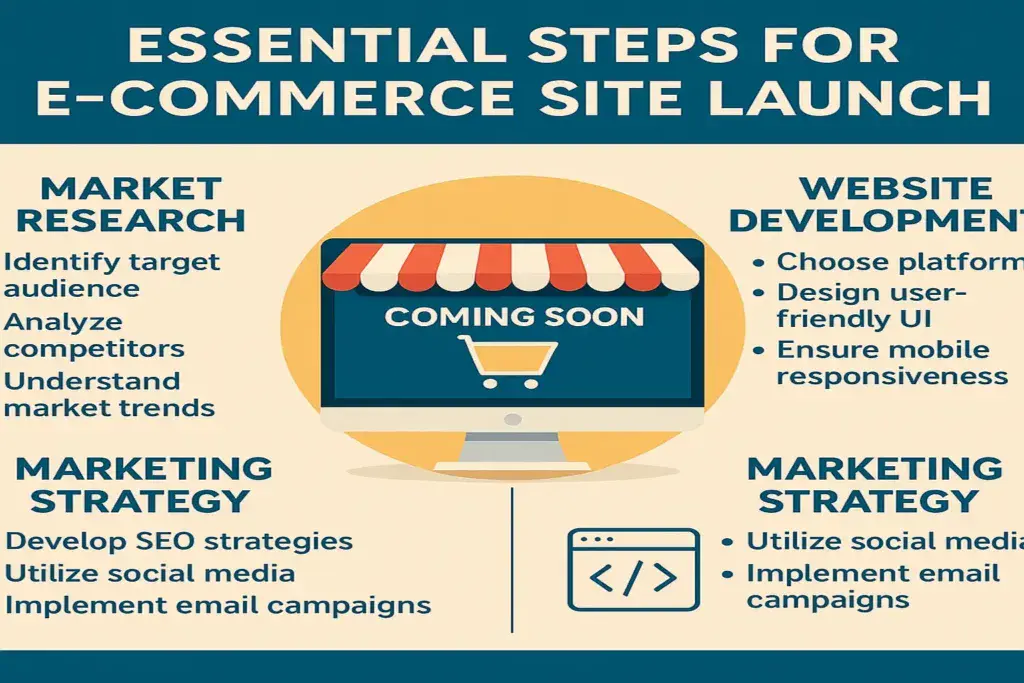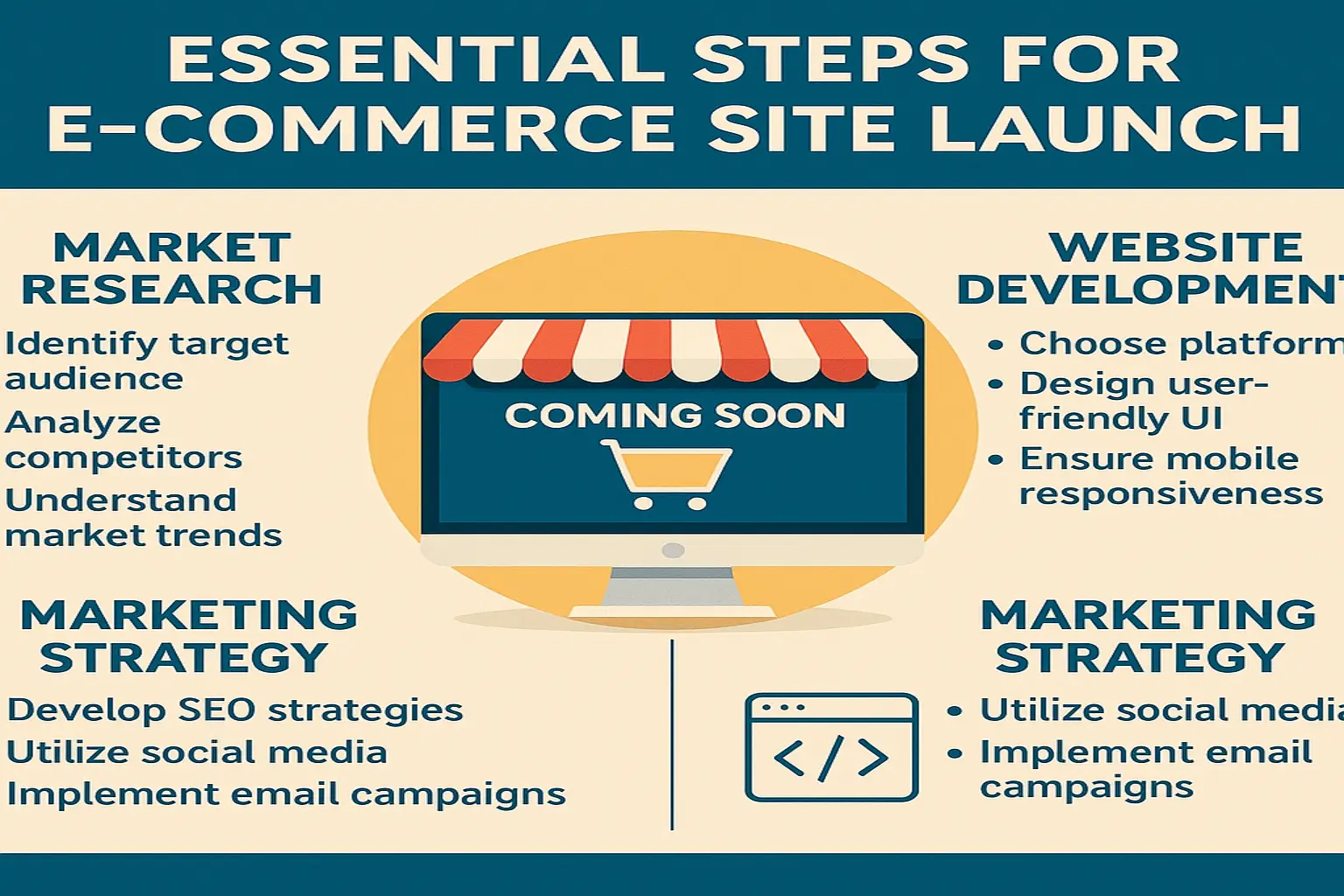
Essential Steps to Prepare for a Successful E-Commerce Site Launch
I. Introduction to E-commerce Site Launch
In today’s digital landscape, following the Essential Steps for a Successful E-Commerce Site Launch is both exciting and challenging. As more consumers shift their shopping habits online, businesses must adapt to meet the growing demand for convenient and user-friendly shopping experiences. An e-commerce site serves as the virtual storefront, where customers can browse products, make purchases, and engage with brands from the comfort of their homes. However, the success of an online retail business hinges on thorough preparation and strategic planning.
Before diving into the technical aspects of building a website, it’s crucial to recognize that a successful e-commerce launch requires a comprehensive understanding of the market, the audience, and the available tools. This preparation phase lays the foundation for all subsequent efforts, from website development to marketing strategies. Without proper groundwork, even the most beautifully designed site may struggle to attract and retain customers.
In this article, we will explore the essential tasks that need to be completed before launching an e-commerce site. From conducting market research to defining a robust marketing strategy, each step plays a critical role in ensuring that your e-commerce business not only launches successfully but also thrives in a competitive marketplace. By following this guide, aspiring e-commerce entrepreneurs can navigate the complexities of the online retail landscape with confidence and clarity.
II. Market Research: One of the Essential Steps for a Successful E-Commerce Site Launch
Before diving into the complexities of launching, conducting thorough market research is one of the Essential Steps for a Successful E-Commerce Site Launch that can significantly influence success. Understanding your market landscape helps you identify opportunities, mitigate risks, and tailor your offerings to effectively meet customer demands. This section will explore three critical components of market research: identifying your target audience, analyzing competitors, and understanding market trends.
A. Identifying Target Audience
The first step in your market research is to define who your target audience is. Knowing your customers is crucial for crafting effective marketing messages, designing your website, and selecting the right products to offer. Start by developing customer personas—detailed profiles that embody the characteristics of your ideal customers. Consider factors such as demographics (age, gender, income level), psychographics (interests, values, lifestyle), and behaviors (shopping habits, preferred payment methods).
To gather data on your target audience, utilize surveys, interviews, and focus groups. Additionally, leverage tools like Google Analytics to analyze website traffic and social media insights to track engagement with your brand. By understanding your audience’s preferences and pain points, you can tailor your offerings and create a compelling value proposition that resonates with them.
B. Analyzing Competitors
Once you have a clear picture of your target audience, it’s time to take a closer look at your competitors. Competitive analysis involves researching other businesses in your niche to identify their strengths, weaknesses, and market positioning. Start by listing your direct competitors—those who offer similar products or services—and indirect competitors—those who fulfill the same customer needs in different ways.
Evaluate their websites, product offerings, pricing strategies, and marketing approaches. Tools like SEMrush and Ahrefs can provide insights into their SEO performance, while social media platforms can reveal how they engage with their audience. Understanding what works for your competitors—and what doesn’t—can help you carve out your unique selling proposition, differentiate your brand, and identify gaps in the market that you can exploit.
C. Understanding Market Trends
Staying informed about market trends is vital for making data-driven decisions and anticipating shifts in consumer behavior. Research industry reports, whitepapers, and market analyses to gain insights into emerging trends, technological advancements, and economic factors that may impact your e-commerce business. Pay attention to consumer preferences, such as the growing demand for sustainable products or the rise of subscription-based services.
Additionally, keep an eye on seasonal trends and changes in shopping behavior, such as peak shopping seasons or the impact of global events. Tools like Google Trends can help you track the popularity of particular search terms over time, giving you a better understanding of consumer interests. By staying ahead of market trends, you can adapt your product offerings and marketing strategies to align with customer expectations, ultimately driving sales and enhancing brand loyalty.
In summary, effective market research is foundational to a successful e-commerce launch. By identifying your target audience, analyzing competitors, and understanding market trends, you can develop a well-informed strategy that positions your business for success in a competitive online landscape.
III. Website Development: A Core Essential Steps for a Successful E-Commerce Site Launch
Once you have completed research, website development becomes another of the Essential Steps for a Successful E-Commerce Site Launch, building the foundation for growth. This phase involves several key components that will lay the foundation for your online store, ensuring it is not only aesthetically pleasing but also functional, efficient, and user-friendly.
A. Choosing the Right Platform
The first decision you’ll need to make in the website development process is selecting the right e-commerce platform. This choice can significantly impact your site’s performance, scalability, and overall success. Popular platforms such as Shopify, WooCommerce, Magento, and BigCommerce each offer unique features and benefits tailored to different business needs. When choosing a platform, consider factors such as ease of use, customization capabilities, payment processing options, and the level of support available. It’s essential to select a platform that aligns with your business goals and can grow alongside your enterprise.
B. Designing a User-Friendly Interface
A well-designed user interface (UI) is paramount to creating a positive shopping experience for your customers. A user-friendly interface should prioritize intuitive navigation, clear calls to action, and aesthetically pleasing design elements. Ensure that your site is easy to navigate, allowing customers to find products quickly and effortlessly. Incorporating high-quality images, detailed product descriptions, and customer reviews can further enhance the user experience. Additionally, consider implementing a streamlined checkout process that minimizes friction, as this can significantly reduce cart abandonment rates.
C. Ensuring Mobile Responsiveness
In today’s digital landscape, mobile responsiveness is no longer optional; it is a necessity. With an increasing number of consumers shopping on their smartphones and tablets, your e-commerce site must be fully responsive to provide an optimal viewing experience across all devices. This means that your website should automatically adjust its layout, images, and content to fit the screen size of the device being used. A mobile-responsive design not only improves user experience but also positively impacts your search engine rankings, as search engines prioritize mobile-friendly sites.
In conclusion, the website development phase is a critical component of your e-commerce site launch. By carefully selecting the right platform, designing a user-friendly interface, and ensuring mobile responsiveness, you set the stage for a successful online business that meets the needs of your target audience while maximizing your potential for growth.
IV. Marketing Strategy: Final Essential Steps for a Successful E-Commerce Site Launch
A strong marketing strategy is also one of the Essential Steps for a Successful E-Commerce Site Launch. Without it, even the best-designed store may struggle to reach customers. A well-thought-out marketing plan will help you reach your target audience, convert visitors into customers, and establish a loyal customer base. In this section, we will explore three essential components of a successful marketing strategy: developing SEO strategies, utilizing social media platforms, and implementing email marketing campaigns.
A. Developing SEO Strategies
Search Engine Optimization (SEO) is a critical element of any e-commerce marketing strategy. By optimizing your website for search engines, you increase your chances of appearing in search results when potential customers look for products or services you offer. Here are some key aspects to focus on:
1. **Keyword Research**: Start by identifying relevant keywords and phrases that your target audience is likely to use when searching for products similar to yours. Use tools like Google Keyword Planner, SEMrush, or Ahrefs to find popular search terms and assess their competition.
2. **On-Page SEO**: This involves optimizing individual pages on your website to rank higher in search results. Ensure that product descriptions, meta tags, headers, and images are optimized with your target keywords. Additionally, focus on providing high-quality content that engages visitors and encourages them to stay on your site longer.
3. **Technical SEO**: Ensure your website has a solid technical foundation. This includes optimizing site speed, ensuring mobile-friendliness, and implementing structured data to help search engines understand your content better. A well-structured website not only improves user experience but also boosts your search engine rankings.
4. **Link Building**: Acquiring backlinks from reputable websites can significantly enhance your site’s authority. Consider guest blogging, collaborating with influencers, or getting featured in industry-related publications to build valuable links.
B. Utilizing Social Media Platforms
Social media platforms are powerful tools for promoting your e-commerce site and engaging with your audience. With billions of users worldwide, platforms like Facebook, Instagram, Twitter, and Pinterest provide a unique opportunity to showcase your products and connect with potential customers. Here are some strategies to consider:
1. **Choosing the Right Platforms**: Identify which social media platforms your target audience frequents the most. For instance, visual products may perform better on Instagram and Pinterest, while B2B products might be more suited for LinkedIn.
2. **Creating Engaging Content**: Share a mix of content types, including product photos, behind-the-scenes videos, customer testimonials, and educational posts related to your niche. Engaging content fosters interaction and encourages followers to share your posts, expanding your reach.
3. **Running Paid Advertising**: Social media advertising allows you to target specific demographics, interests, and behaviors, ensuring that your ads reach the right people. Consider running promotions, discounts, or contests to attract attention and generate sales.
4. **Building a Community**: Engage with your audience by responding to comments, answering questions, and encouraging user-generated content. Building a community around your brand fosters loyalty and encourages repeat business.
C. Implementing Email Marketing Campaigns
Email marketing remains one of the most effective channels for driving sales and nurturing customer relationships. A well-executed email marketing strategy can keep your audience informed about new products, promotions, and company news. Here are some best practices:
1. **Building an Email List**: Start collecting email addresses from the moment you launch your site. Offer incentives such as discounts, exclusive content, or early access to products in exchange for subscribers’ email addresses.
2. **Segmentation**: Divide your email list into segments based on customer behavior, preferences, or demographics. Segmentation allows you to tailor your messages to specific groups, increasing the relevance of your communications.
3. **Crafting Compelling Content**: Create engaging and visually appealing emails that resonate with your audience. Use clear subject lines, personalized greetings, and strong calls to action to encourage recipients to take action.
4. **Analyzing Performance**: Track the performance of your email campaigns through metrics such as open rates, click-through rates, and conversion rates. Use this data to refine your strategy and improve future campaigns.
In summary, a well-rounded marketing strategy is vital for the success of your e-commerce site. By developing effective SEO strategies, leveraging social media platforms, and implementing targeted email marketing campaigns, you can maximize your reach, engage your audience, and drive sales. As you prepare for your launch, keep these marketing tactics in mind to ensure you hit the ground running.
V. Conclusion and Key Takeaways
Launching an e-commerce site is a multifaceted process that requires careful planning and execution. As we have explored throughout this article, several essential tasks must be addressed prior to launching your online store to ensure its success.
First and foremost, thorough **market research** is crucial. By identifying your target audience, analyzing competitors, and understanding market trends, you can position your e-commerce business strategically within the marketplace. This foundational knowledge will not only inform your product offerings but also help you tailor your marketing efforts more effectively.
Next, the **website development** phase is where your vision begins to take shape. Choosing the right platform is essential to support your business model, while a user-friendly interface and mobile responsiveness can significantly enhance the customer experience. Remember, a well-designed website can make the difference between a visitor and a loyal customer.
When it comes to your **marketing strategy**, developing robust SEO strategies, utilizing social media platforms, and implementing email marketing campaigns will play a pivotal role in driving traffic to your site and engaging potential customers. These tactics not only help in reaching a wider audience but also foster a community around your brand.
In summary, the successful launch of an online store depends on following the Essential Steps for a Successful E-Commerce Site Launch: research, website development, and a strong marketing strategy. By conducting comprehensive market research, developing a user-friendly website, and implementing an effective marketing strategy, you lay a solid foundation for your e-commerce venture. Keep these key takeaways in mind as you embark on your journey, and you will be well-equipped to navigate the dynamic landscape of online retail.
What are the Essential Steps for a Successful E-Commerce Site Launch?
The Essential Steps for a Successful E-Commerce Site Launch include thorough market research, website development, and a strong marketing strategy. These steps ensure your site attracts visitors, provides a smooth shopping experience, and converts leads into loyal customers.
Why are the Essential Steps for a Successful E-Commerce Site Launch important?
Following the Essential Steps for a Successful E-Commerce Site Launch is crucial because they provide a structured approach to building and promoting your online store. Without these steps, businesses risk poor visibility, low conversions, and customer dissatisfaction.
How does market research fit into the Essential Steps for a Successful E-Commerce Site Launch?
Market research is one of the most vital Essential Steps for a Successful E-Commerce Site Launch. By understanding your target audience, competitors, and industry trends, you create a foundation that informs product offerings, website design, and marketing campaigns.
Which technical aspects are part of the Essential Steps for a Successful E-Commerce Site Launch?
Website development and technical setup form the backbone of the Essential Steps for a Successful E-Commerce Site Launch. Choosing the right platform, ensuring mobile responsiveness, and implementing secure payment gateways directly impact user experience and trust.
How does marketing contribute to the Essential Steps for a Successful E-Commerce Site Launch?
Marketing is one of the key Essential Steps for a Successful E-Commerce Site Launch, as it drives traffic, builds brand awareness, and fosters customer loyalty. Effective SEO, social media campaigns, and email marketing help maximize reach and boost conversions.



